香港朗文二年级下册
香港朗文二年级下册第五课
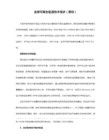
Here's an example.
例子。
I like swimming. Do you like swimming?
我喜欢游泳。你喜欢游泳吗?
No, I don't like swimming but I like running.
你喜欢什么运动?和你的搭档一起选择一个俱乐部来加入。
Language Fun
趣味语言
F Say the tongue twisters.
F 说这个绕口令。
Bill and Ben bounce a basketball on the basketball court.
比奥和本在篮球场上拍打一个篮球。
你可以写一个新的绕口令吗?
Tennis
网球
My name is Wendy. I like playing tennis.
我的名字是温蒂。我喜欢打网球。
I play with a racket and a tennis ball.
我用网球拍和网球来做这项运动。
What do you hit a tennis ball and a table tennis ball with?
D Circle the correct answers.
D 圈出正确的答案。
1 Mike likes playing football. Which is his ball?
1 麦克喜欢踢足球。哪一个是他的球?
2 Who plays table tennis?
2 谁打乒乓球?
Mike, Yin Fong or Wendy.
不,我不喜欢游泳,但是我喜欢跑步。
香港朗文英语二年级下Unit 1 Fast food
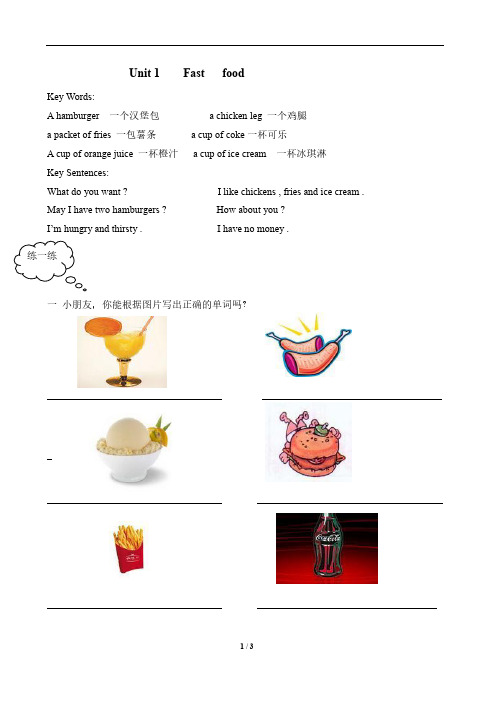
Unit 1 Fast foodKey Words:A hamburger 一个汉堡包 a chicken leg 一个鸡腿a packet of fries 一包薯条 a cup of coke一杯可乐A cup of orange juice 一杯橙汁 a cup of ice cream 一杯冰琪淋Key Sentences:What do you want ? I like chickens , fries and ice cream . May I have two hamburgers ? How about you ?I’m hungry and thirsty . I have no money .一小朋友,你能根据图片写出正确的单词吗?二小小翻译家,请把下列短语或句子汉译英!1.五个汉堡包2.两杯冰淇淋3.七包署条4.八个鸡腿5.三杯橘子汁6.六杯可乐7.没有钱8.我能帮你吗?9.我喜欢署条和冰淇淋。
10.我很抱歉!三快来比一比,赛一赛,看谁又快又准!【】1、There _______ two packets of fries.A、amB、isC、areD、/【】2、I______ hungry and thirsty,too.A、areB、isC、amD、/【】3、I don’t _____ hamburgers.A、likesB、likeC、likedD、liking 【】4、I have no money.___ I have no money,_____ .A、tooB、alsoC、eitherD、/【】5、What do you______ ?A、wantsB、wantingC、wantD、wanted每个人的生日树 Birthday TreeDecember 23 to January 1 ........... Apple Tree(苹果树)January 2 to January 11 .............. Fir Tree(冷杉、杉木) January 12 to January 24 ............ Elm Tree(榆树)January 25 to February 3 .............Cypress Tree(柏树)February 4 to February 8 ............. Poplar Tree(白杨)February 9 to February 18 ............Cedar Tree(雪松)February 19 to February 28 .......... Pine Tree(松树)March 1 to March 10 .............. .....Weeping Willow Tree(垂柳) March 11 to March 20 ............. .....Lime Tree(欧椴树、酸橙树) March 21 ......................... ...... ...Oak Tree(橡树)March 22 to March 31 ............. .....Hazelnut Tree(榛树) April 1 to April 10 .............. ...... ...Rowan Tree(花楸树) April 11 to April 20 ............. ...... ..Maple Tree(枫树)。
香港朗文英语二年级下Unit 7 Weather and seasons

Unit 7 Weather and seasonsKey Words:wet 潮湿的 hot 热的 windy 有风的 cold 寒冷的 beach 沙滩 poem 诗歌spring 春天summer 夏天 autumn 秋天 winter 冬天 Key Sentences:I can feel the sun/rain/wind/snow .Let ’s go to the beach/zoo .Don ’t fly away .We can ’t fly the kite .一 小朋友,你能根据图片写出正确的单词吗?二小小翻译家,请把下列短语或句子英汉互译!1.放风筝2.Come back, kite .3.去沙滩4.too cold5.在秋天6.in Spring7.回家8.your favourite season9.在夏天10.in winter三快来比一比,赛一赛,看谁又快又准!【】1、It’s wet.I can _____ the rain .A feel B、play C、swim D、run【】2、Let’s go ____ the beach .A、toB、inC、onD、at【】3、In spring,it’s so ____ .A、hotB、coldC、wetD、windy 【】4、We can’t ____ the kite .A、walkB、flyC、goD、play【】5、fly away .A、Don’tB、Doesn’tC、DoesD、Does not 【】6、Let’s ____ .A、go in homeB、go homeC、go to homeD、go at home 【】7、In ______ ,it is so hot .A、springB、summerC、autumnD、winter8.Wow,it’s ____ kite .A、aB、anC、theD、/【】9、I can feel the wind.It’s _____ .A、wetB、windyC、hotD、good【】10、Angel is _____ Tony in Hong Kong .A、visitB、visitingC、visitedD、visits读一读英语中12个月名称的由来January---1月在罗马传说中,有一位名叫雅努斯的守护神,生有先后两副脸,一副回顾过去,一副要眺望未来。
香港朗文二年级下册第三课
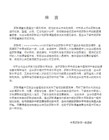
第三课 我的一天
Key Words
关键词
1 wash my face
1 洗脸
2 brush my teeth
2 刷牙
3 have breakfast
3 吃早餐
4 do my homework
4 做作业
5 have a shower
5 洗澡
6 go to bed
6 睡觉
E Beeno正在写信给他的笔友。帮他完成这封信。
Here's an example.
例子。
Dear Momo, My name is Beeno.
亲爱的默默,我的名字是Beeno。
I live on Mars. Do you want to be my pen friend?
我住在火星上。你想成为我的笔友吗?
Mother Bird sees the cat. It is waiting by the nest.
鸟妈妈看见了猫。它正在鸟巢旁边等。
4 I must stop that cat.
4 我必须阻止那只猫。
That night Mother Bird has an idea.
那天晚上鸟妈妈想到一个主意。
例子。
It's time to brush your teeth.
你该刷牙了。
What's the time?
现在几点?
It's seven oh five.
现在7点零5分。
Now you try.
现在你来试。
Learn to Read
学着读
C How does Mother Bird look after her babies? Read and find out.
深港朗文英语二年级下6-7课测试卷含材料及答案
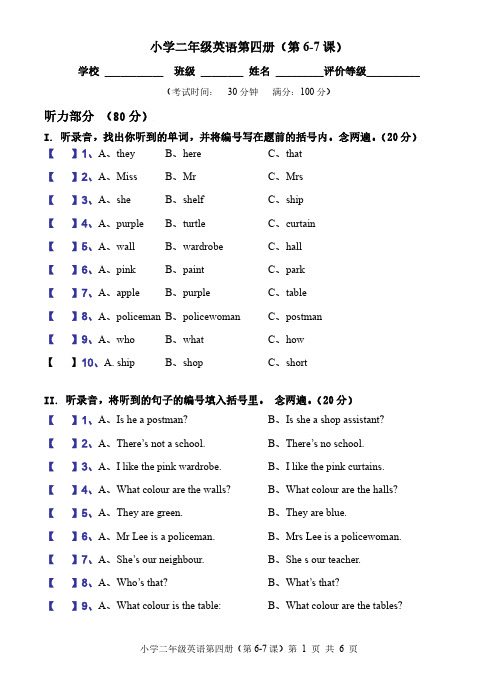
小学二年级英语第四册(第6-7课)学校___________ 班级________ 姓名_________评价等级__________(考试时间:30分钟满分:100分)听力部分(80分)I. 听录音,找出你听到的单词,并将编号写在题前的括号内。
念两遍。
(20分)【】1、A、they B、here C、that【】2、A、Miss B、Mr C、Mrs【】3、A、she B、shelf C、ship【】4、A、purple B、turtle C、curtain【】5、A、wall B、wardrobe C、hall【】6、A、pink B、paint C、park【】7、A、apple B、purple C、table【】8、A、policeman B、policewoman C、postman【】9、A、who B、what C、how【】10、A. ship B、shop C、shortII. 听录音,将听到的句子的编号填入括号里。
念两遍。
(20分)【】1、A、Is he a postman? B、Is she a shop assistant?【】2、A、There’s not a school. B、There’s no school.【】3、A、I like the pink wardrobe. B、I like the pink curtains.【】4、A、What colour are the walls? B、What colour are the halls?【】5、A、They are green. B、They are blue.【】6、A、Mr Lee is a policeman. B、Mrs Lee is a policewoman.【】7、A、She’s our neighbour. B、She s our teacher.【】8、A、Who’s that? B、What’s that?【】9、A、What colour is the table: B、What colour are the tables?【】10、A、There is a bed is my room. It’s red.B、There is a shelf in my room. It’s black.III. 听录音,将下列图片与相关的颜色连线。
香港朗文二年级下册
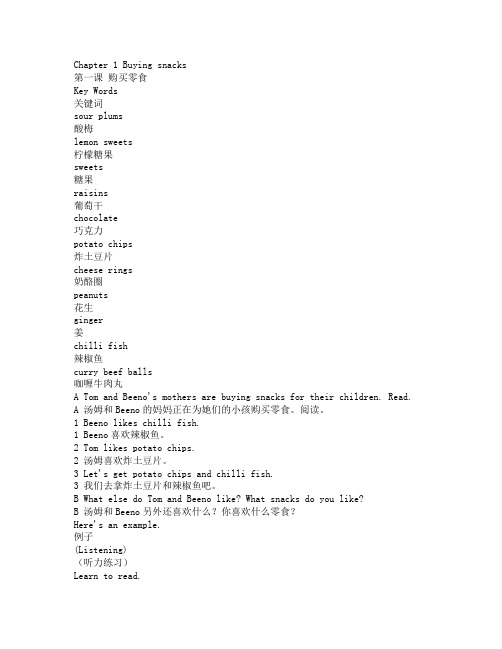
Chapter 1 Buying snacks第一课购买零食Key Words关键词sour plums酸梅lemon sweets柠檬糖果sweets糖果raisins葡萄干chocolate巧克力potato chips炸土豆片cheese rings奶酪圈peanuts花生ginger姜chilli fish辣椒鱼curry beef balls咖喱牛肉丸A Tom and Beeno's mothers are buying snacks for their children. Read.A 汤姆和Beeno的妈妈正在为她们的小孩购买零食。
阅读。
1 Beeno likes chilli fish.1 Beeno喜欢辣椒鱼。
2 Tom likes potato chips.2 汤姆喜欢炸土豆片。
3 Let's get potato chips and chilli fish.3 我们去拿炸土豆片和辣椒鱼吧。
B What else do Tom and Beeno like? What snacks do you like?B 汤姆和Beeno另外还喜欢什么?你喜欢什么零食?Here's an example.例子(Listening)(听力练习)Learn to read.学着读。
C What snacks do the Chow family like? Read and find out.C 周一家喜欢什么零食?阅读,找出答案。
1 Charlie, Cherry and their mother are in the supermarket.1 查理和查瑞还有他们的妈妈正在超级市场里面。
The children want some snacks. Charlie likes lemon sweets but Cherry does not like them.小朋友们想要一些零食。
香港朗文英语二年级下unit 2 Meals I like
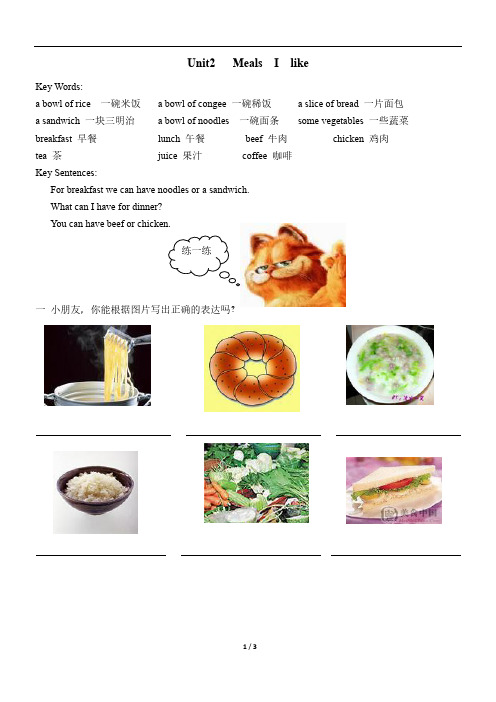
Unit2 Meals I likeKey Words:a bowl of rice 一碗米饭 a bowl of congee 一碗稀饭 a slice of bread 一片面包a sandwich 一块三明治 a bowl of noodles 一碗面条some vegetables 一些蔬菜breakfast 早餐lunch 午餐beef 牛肉chicken 鸡肉tea 茶juice 果汁coffee 咖啡Key Sentences:For breakfast we can have noodles or a sandwich.What can I have for dinner?You can have beef or chicken.一小朋友,你能根据图片写出正确的表达吗?二小小翻译家,请把下列短语或句子汉英互译!1. 一些蔬菜2. I like chicken .3. 牛肉面条4. the country mouse5. 桔子汁6. Don’t worry .7. 咖啡8. hurry up9. 三明治10. I can’t sleep .三快来比一比,赛一赛,看谁又快又准!【】1、____you hungry?A、amB、isC、areD、/【】2、Lily can have rice,noodles______bread for supper.A、andB、manyC、muchD、or 【】3、The city mouse is_______his nephew in the country.A、visitingB、visitC、visitsD、visited 【】4、What can I have______breakfast?A、toB、forC、withD、on 【】5、I can’t_______.A、eatB、eatsC、eatingD、eating 四动一动脑,小朋友能正确的连词成句吗?1. have , a , sandwich , can , you , or , a , cake2. only , plane , a , is , it3. dinner , you , have , chicken , fish , or , for , can4. and , eat , up , hurry5. am , I , home , going每个人的生日树Birthday TreeApril 21 to April 30 ............. ..Walnut Tree(胡桃树) May 1 to May 14 .................. Poplar Tree(白杨) May 15 to May 24 .................Chestnut Tree(栗子树) May 25 to June 3 ................. Ash Tree(á¯树)June 4 to June 13 ................ Hornbeam Tree(角树) June 14 to June 23 ............... Fig Tree(无花果树) June 24 .......................... ... Birch Tree(桦树)。
教学设计方案朗文英语2Bchapter4(20200701104347)

教学设计方案课程香港版朗文英语教材二年级下册 Chapter 4课程标准这一话题是《新英语课程标准》里面二级标准中的“语言知识”部分,是语言运用的能力重要组成部分。
教学内容分析本课内容是港版朗文英语教材2B Chapter 4,本单元的主题是如何在家中帮忙家务,主要学习家务活动六个活动短语,以及学习如何询问别人在家怎么帮忙家里干家务活。
对不同人物、人称进行询问,以及在交流孩子们的日常生活中设计的简单日常用语。
本单元核心知识点是之前没有学习过的所以要求扎实掌握六个短语的认读,准确理解含义,并能灵活运用。
问句的学习中涉及不同人称的运用这是本单元的难点知识,要合理的安排教学活动设学生容易掌握,尽量多设计有效的教学环节来操练,提高学生的语言运用能力。
教学目标“四会”掌握词汇:wash the dishes set the table sweep the floor make the bed tidy the room water the plants句型:询问别人如何帮忙干家务活:How do you help at home? I sweep the floor.How does she help at home? She sweeps the floor.How does he help at home? He sets the table.学习目标学生能用本课的短语和句型询问别人在家是如何帮忙家务活的,并能表达自己在家的日常生活表现。
学情分析学习朗文英语的二年级的学生具有一定的语言基础,能很快的习得简单的日常用语。
但他们年龄小活泼好动,学习热情容易别调动起来,也能主动积极参与教学活动,也容易控制不住自己的情绪。
同时他们对自己的生活、朋友们的生活都充满着兴趣。
对待父母和家庭开始有些简单的理解。
所以教学可以结合孩子们在家的真实表现以及不同家庭的特有氛围来带动孩子们更好的去理解父母和家庭,并通过相互的比较,引导孩子尽自己力所能及的去帮助家里人干家务。
深港朗文英语2年级下Unit 1
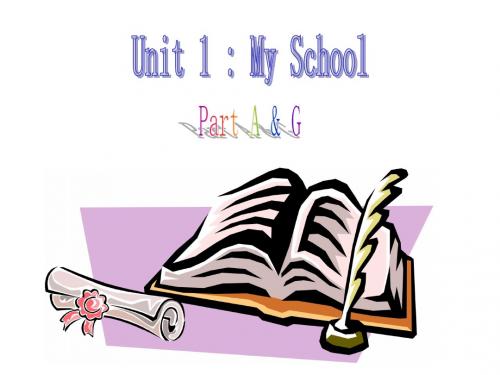
The name of my school is Bibo Primary School. Welcome to my school!
Is there…?
Are there…?
Sum up
Is there …?
Yes, there is. No, there isn’t.
Sum up
Are there …?
There are six lights.
There are three pictures.
…
Hi, I am Mike. I want to visit your school !
What’s in your school ?
What’s in your school?
There’s…
an art room
a playground
a swimming pool
a hall
a washing room
an art room
Is there
a swimming pool a classroom? a washing room? a hall? a computer room? a playground?
1.There is an art room. Is there an art room? 2. There is a computer. Is there a computer?
3. There are six fans. Are there six fans?
.
.
.
4. There are 24 classrooms. Are there 24 classrooms? __________________________________.
二年级下英语教案-Unit 2 At school_深港朗文版
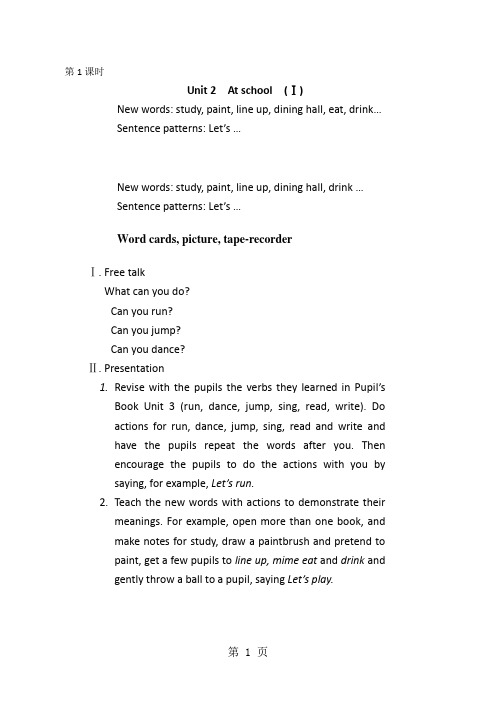
第1课时Unit 2 At school (Ⅰ)New words: study, paint, line up, dining hall, eat, drink…Sentence patterns: Let’s …New words: study, paint, line up, dining hall, drink …Sentence patterns: Let’s …Word cards, picture, tape-recorderⅠ. Free talkWhat can you do?Can you run?Can you jump?Can you dance?Ⅱ. Presentation1.Revise with the pupils the verbs they learned in Pupil’sBook Unit 3 (run, dance, jump, sing, read, write). Doactions for run, dance, jump, sing, read and write andhave the pupils repeat the words after you. Thenencourage the pupils to do the actions with you bysaying, for example, Let’s run.2.Teach the new words with actions to demonstrate theirmeanings. For example, open more than one book, andmake notes for study, draw a paintbrush and pretend topaint, get a few pupils to line up, mime eat and drink andgently throw a ball to a pupil, saying Let’s play.3.Drill the new words by saying a word and getting thepupils to do the appropriate action or by doing an action and getting the pupils to say Let’s …4.Show Transparency and play the tape. Ask the pupils torepeat the words in the speech bubbles after the beeps.Do the same with the vocabulary items.Ⅲ. Practice1.Show Transparency. Point to the children on the pagewho are painting. Say Let’s paint. Get the pupils to do the action and join in with them. Let’s line up.2.Point to the other words. Ask the pupils to repeat themafter you and to do the action you have taught them. 3.Ask the pupils to work in groups of four. Give a word cuelike study.Nominate one pupil in the group to make a sentence with Let’s …and to invite Ss to do the action with him or her.1.Copybook 52.Workbook 63. Write the new words on the notebook. Unit 2 At schoolwords (picture cards) Let’s study. Let’s paint. Let’s line up.The activity that teacher give orders (say the words) and pupils do actions is good for memorizing the new words and sentence pattern.第2课时Unit 2 At school (Ⅱ)New words: sing, play, study …Sentence patterns: What do you do in the …? We … and …New words: sing, play, study …Sentence patterns: What do you do in the …? We … andWord cards, picture, tape-recorderⅠ. GreetingHow are you today?Is there a library in the school?Can we shout in the library?Ⅱ. Presentation1.Bring in the plan of the school again.2.Point to an appropriate room on the plan. Make sentences aboutwhat the pupils do in the room. For example, say We study in the classroom.3.Drill the pupils by asking about the different rooms, e.g. What do youdo in the dining hall?Encourage the more able pupils to use more than one verb by saying And? With rising intonation after they have told you one thing they do, e.g. S: We eat. T: And? S: We drink.4.Show Transparency and play the tape. Point to the speech bubblesand get the pupils to repeat the sentences after the beeps.Ⅲ. Practice1.Show Transparency and play the tape. The pupils listen and follow intheir books. Continue to play the cassette and ask the pupils to repeat the words after the beeps.2.Show Ss the characters and explain Mike is in Pat’s school.3.Point to the pictures and ask, for example, what do you do in theplayground? Encourage the pupils to make a sentence about each small picture in the thought bubbles.4.Show the pupils, using the sentences in the speech bubbles, thatwhen we talk about more than one thing we can use … and … to link the actions. We can also use …, too to link a sentence to a previous sentence.5.Point to Pat’s thought bubbles in picture 3. help Ss to link the actionsshown by saying … and … or …, too.6.Ask the pupils to work in pairs to complete the conversation. Thepupils take turns to role-play P and M.1.Copybook 62.Workbook 73. Review what welearned today.Unit 2 At school What do you do in the playground? We line up and sing.We play, too.Enlargement:1.We surf the internet/ play computer game in the computer room.2.We sing and dance/ have a show in the hall.3.We swim in the swimming pool.jump, run, read, write, etc.第3课时Unit 2 At school (Ⅲ)Words: here ,pool, coolSentence patterns “What do you do in the …?”“We …and …”“We play in the …”the sentence patterns of “ What do you do in the …?”the sentence patterns of “ What do you do in the …?”Picture cards, tape-recorderⅠ. GreetingWhat do you do at home?We eat and drink.We play, too.Ⅱ. Presentation1.Point to the characters in the pictures and read their speechbubbles aloud. Ask the pupils to point to the speech bubbles as you read them.2.Play the Pupil’s Book Cassette for the pupils and ask them to saythe sentences after the cassette.3.Pupils say the speech bubbles together. And then say them groupby group, see which group is best.4.Ask the pupils to role-play the story in groups of three and to readthe characters’ speech bubbles. Some groups may like to come out to the front and act the story.e the storycards to revise sequence and language of the story.Ⅲ.Do the part D1.Ask the pupils to read the story again. Read the words in thespeech bubble with pupils and tell them to repeat the sentences.2.Demonstrate how to write a cross in the first one as an example.e Transparency to check the answers.Ⅳ. More to do1.Write the names of the different rooms on the board. Using stripsof paper with the action verbs written on them, ask the pupils to stick a strip of paper under an appropriate room name.2.Ask a pupil about a room, for example, what do you do in themusic room? The pupil makes a sentence using the word on the strip of paper under the room name. This game can also be played in teams for points.1.Copybook 72.Workbook 83. Review what welearned today.Unit 2 At schoolWe fly in here.We read in the swimming pool. Your school’s cool.Role-playing and acting out the story gain a good effect.Retelling the story with the help of teacher help pupils understand the story.第4课时Unit 2 At school (Ⅳ)The pronunciation of “ea” in the following words: ice cream, seat,read, eatpronunciation ea in the words: ice cream, seat, read, eatpronunciation ea in the words: ice cream, seat, read, eatPicture cards, word cards, tape-recorderⅠ. GreetingWhat’s your favourite food?Do you like apple?Do you like ice cream?Ⅱ. Presentation1.Play the Pupil’s Book Cassette and ask the pupils to listen to thesound and the words.2.Point out the spelling of this sound. It is important that the pupilsrealize the vowel sound is spelt with two letters.3.Say the words slowly and clearly. Check that the pupils are sayingthe sounds correctly.4.Point to the pictures and check that the pupils to listen to therhyme and point to the children. Ask the pupils to read what is written on the wrappers of each child’s ice cream. Tell them to circle the winner. Get the pupils to say the rhyme.Ⅲ. Play the game1.Write the names of the different rooms on the board. Using stripsof paper with the action verbs written on them, ask the pupils to stick a strip of paper under an appropriate room name.2.Ask a pupil about a room, for example, What do you do in themusic room? The pupil makes a sentence using the word on the strip of paper under the room name. This game can also be played in teams for points.Ⅳ. Do workbook.(P9)1.Ask Ss to look at the first part of the page and listen to the tape.They need to circle the correct TVs according to the sound theyhear on the tape.2.Ask the pupils to look at the second part of the page. Tell them tolook at the pictures and fill in the blanks in the sentences.1.Copybook 82.Workbook 93. Review what welearned today.Unit 2 At school What do you do in the playground? We line up and sing.What do you do in the music room? We sing and dance.第5课时Unit 2 At school (Ⅴ)Get pupils to be more familiar with the words and thesentence patterns “ What do you do in the …?”“We …and …”…words and the sentence patterns “ What do you do …?”words and the sentence patterns “ What do you do …?”word cards, pictures and tape-recorderⅠ. Free talkWhat do you do in the playground?I play…What do you do in the classroom?I study………Ⅱ. Word revisionReview the words. Ask some pupils do actions for study, paint, line up, eat, drink…the others guess the wordsand spell the words.Choose some students to spell the words, and choose some able students, make sentences with words.Ⅲ. Presentation ( F. Look and do. P.11)1.Ask the pupils to draw their own face in the blank faceson page 62. Tell them to cut out the pictures and to stick them in the four rooms at the top of page 11. Tell them not to show their friend.2.Tell the pupils to work in pairs. Ask them to take turns toask What do you do in the …? The other pupil answers according to the picture he or she has put in that room.The pupil asking the questions ticks the correct boxes in the grid at the bottom according to their partner’s answer.3.At the end, the pupils check to see if their pictures andtheir partner’s grid match.Ⅳ. More to doThe pupils draw a picture of their favorite room in the school. They write a caption to tell what they do there.Ⅴ. SummaryWhat do you do in the library?I study.What do you do in the dining hall?We eat and drink.What do you do in the …?1.Workbook 102.Review the words3.Review what we learned today.Unit 2 At schoolWhat do you do in the library?I study.What do you do in the dining hall? We eat and drink.第6课时Unit 2 At school (Ⅵ)Consolidate all the new words and sentence patterns of Unit 2Sing the songsNew words and sentence patternsSentence patternsWord cards, picture cards, tape-recorderⅠ. GreetingWhat do you do in the home?I do my homework.I eat and drink. I play, too.Ⅱ. Revision1.Review the new wordsstudy, paint, line up, dining hall, eat, drink, do, weat school, well2. Review sentence patterns.What do you do in the playground?We line up and sing. We play, too.What do you do in the classroom?We study.What do you do in the dining hall?We eat and drink.What do you do in the art room?We paint and draw.Ⅲ. Sing and play1.Play the Pupil’s Book Cassette for the pupils to listen tothe song. Ask the pupils What do you do in the …? For each of the rooms listed at the bottom of the page.2.Play the cassette again and tell the pupils to point to thecorrect pictures for each of the verses.3.Play the cassette again and encourage the pupils to joinin with the words.Ⅳ. The pupils play a miming game.Give a pupil a strip of paper with a verb from this unit written on it. The pupil reads the word on the strip of paper silently and then mimes the action. The others guess what action he or she is doing by making a sentence like We sing in the music room. Award points for correct guesses.Ⅴ. Summary1.Review theunit.2.Recite PartAand PartB3.Prepare Unit3。
香港朗文英语二年级下unit 4 Feeling happy
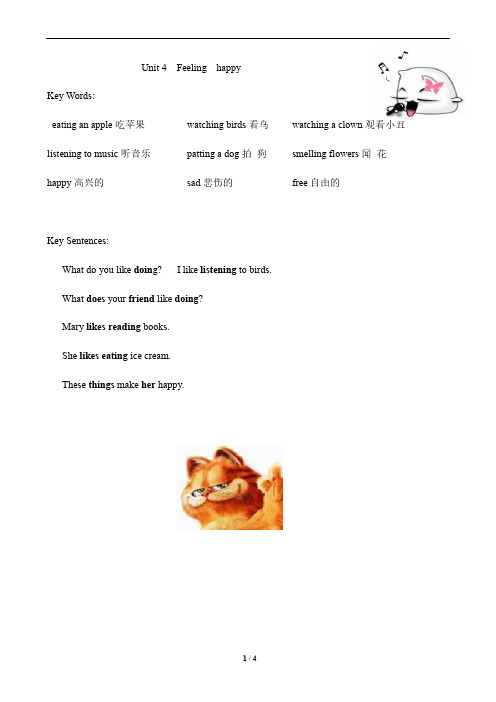
Unit 4 Feeling happyKey Words:eating an apple吃苹果watching birds看鸟watching a clown观看小丑listening to music听音乐patting a dog拍狗smelling flowers闻花happy高兴的sad悲伤的free自由的Key Sentences:What do you like doin g? I like listening to birds.What does your friend like doing?Mary likes reading books.She likes eating ice cream.These things make her happy.一小朋友,你能选出正确的词将句子补充完整吗?【】1、I can’t ________ the little bird.A、hearingB、hearsC、hearD、heard【】2、Your singing ________ me happy.A、makesB、makingC、makeD、maked 【】3、Please sing _______ me.A、inB、onC、toD、for【】4、Why _______ you sad?A、doB、didC、doesD、are【】5、May _______ singing songs.A、likingB、likeC、likedD、likes【】6、Tom is ________ birds.A、listen toB、listenC、listening toD、listening 【】7、These things make ________ happy.A、heB、sheC、herD、they【】8、Betty likes playing ________.A、footballB、footballsC、the footballD、a football 【】9、Jane likes reading ________.A、bookB、a bookC、booksD、much book 【】10、do you like doing?A、HowB、WhenC、WhatD、Where二小小翻译官,你来试一试吧,将下列词组英汉互译!1. listening to music .2.许多3. smelling flowers .4.冰淇淋5. patting a dog6. 小鸟7. watching a clown 8. 一个苹果9. touching soft thing 10. 在笼子里三请小朋友用括号里单词的正确形式填空。
二年级朗文英语下册(2B)语法知识点归纳(K12教育文档)

二年级朗文英语下册(2B)语法知识点归纳(word版可编辑修改)编辑整理:尊敬的读者朋友们:这里是精品文档编辑中心,本文档内容是由我和我的同事精心编辑整理后发布的,发布之前我们对文中内容进行仔细校对,但是难免会有疏漏的地方,但是任然希望(二年级朗文英语下册(2B)语法知识点归纳(word版可编辑修改))的内容能够给您的工作和学习带来便利。
同时也真诚的希望收到您的建议和反馈,这将是我们进步的源泉,前进的动力。
本文可编辑可修改,如果觉得对您有帮助请收藏以便随时查阅,最后祝您生活愉快业绩进步,以下为二年级朗文英语下册(2B)语法知识点归纳(word版可编辑修改)的全部内容。
二年级朗文英语下册(2B)语法知识点归纳:第一单元:单词:chill fish 麻辣鱼chocolate 巧克力ginger 姜糖potato chips 薯片lemon sweets 柠檬糖peanuts 花生sour plums 话梅curry beef balls 咖喱牛肉丸cheese rings 奶酪圈注意:要能区分哪些是可数名词,哪些是不可数名词.蓝色:不可数名词红色:可数名词句型:1。
太多了too much 用于不可数名词too many 用于可数名词2。
I like cookies. 我喜欢饼干。
3。
Do you like cookies? 你喜欢饼干吗?肯定回答:Yes, I do。
否定回答:No, I don't.4. I don’t like cookies。
我不喜欢饼干。
5。
Beeno likes cookies. Beeno喜欢吃饼干.(Beeno是第三人称单数,后面的动词like加s)6。
Does Beeno like cookies? Beeno喜欢吃饼干吗?(有了does,like不加s)肯定回答:Yes, he does.否定回答:No, he doesn’t。
7. Beeno doesn’t like cookies。
二年级下英语教案-Unit 1 My school_深港朗文版
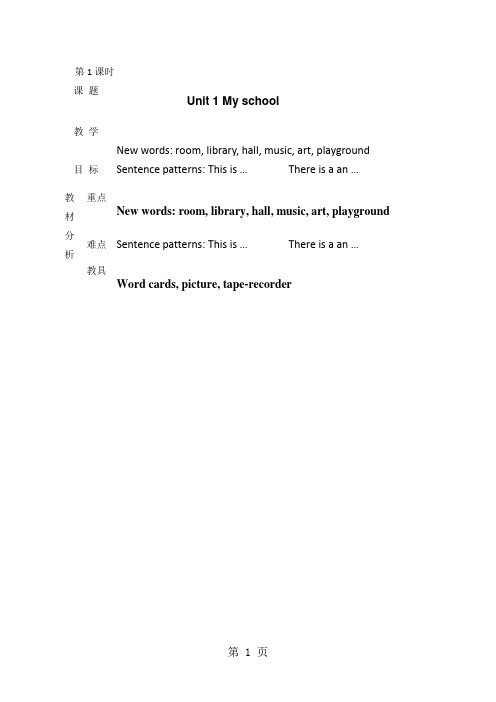
第1课时课题Unit 1 My school 教学目标New words: room, library, hall, music, art, playground Sentence patterns: This is …There is a an …教材分析重点New words: room, library, hall, music, art, playground 难点Sentence patterns: This is …There is a an …教具Word cards, picture, tape-recorder教学过程I. Free talkⅡ. Presentation1.Bring in a picture of a school and photos or pictures of thedifferent rooms taught in the Unit.2.( Books closed ) Show the picture of you the school, sayingThis is my school. Give individual pupils the picture and ask them to repeat the sentence.3.Show the pictures of the different rooms in the school. Saytheir names and ask the pupils to repeat them after me Then practise by showing a room and asking the pupils to tell me the name.4.Choose a picture and point to something in the picture thepupils know, e. g. a tree, a well-known room and say There’s a/an …Show the picture to individual pupils and ask them to point to the object and repeat the sentence. Point to other known items in the picture and encourage them to make sentences about them.5.Play the Pupil’s Book Cassette and point to the speechbubble. Ask the pupils to repeat after the beeps.Ⅲ. Practice1.( Books open ) Show Transparency. Point to the places in theschool on the page, saying There’s a classroom, etc.Encourage the pupils to repeat the sentences after you.2.Introduce the new character, Mike. Explain that Tim isshowing Mike a picture of his school. Teach the pupils the name of the school ( No. 1 Primary School ).教学过程3.Read Tim’s speech bubble. Get the pupils to point to thecorrect places. Make sentences about the other places using There’s a/an …4.Encourage the pupils to make sentences by using there is a/an…while I point to the places in the picture.5.Get the pupils to look at each of the rooms. Point at anobject in a room and say There’s a …布置作业1.Copybook 12.Workbook 13. Write the newwords on thenotebook.板书设计Unit 1 My schoolwords(picture cards)This is my school.There’s an art room.There’s a library.教学后记1.Teaching new words with motions impresses pupils.ing ‘a’ and ‘an’ should be emphasized.3. Pupils feel hard in pronouncing the words library, hall, and playground.第2课时课题Unit 1 My school教学目标New words: art room, music room, hall, library …Sentence patterns: Welcome to …Is there a …Yes, there is./ No, there isn’t.New words: art room, music room, hall, library…Sentences: Is there a … Yes, there is. / No, there isn’t.Word cards, picture, tape-recorderⅠ. Free talkⅡ. PresentationMake a plan of your school with the places marked on it.The plan does not need to have the English names written on it.( Books closed ) Show the pupils a plan of your school with the places marked on it, revising the English names for the places.Point to the plan and ask, for example, Is there a music room? Ask a pupil to come out and point to the place named and say Yes, there is. Ask about a place not in the school, e.g. Is there a swimming pool? Is there a zoo? Then teach No, there isn’t.4. ( Books open ) Show Transparency. Play the Pupil’sBook Cassette and ask the pupils to repeat the characters’ words after the beeps.Ⅲ. Practice1.Show Transparency and play the Pupil’s Book Cassette.Explain that Tim and Pat are visiting Mike’s school. The Ss listen and follow in their books. Continue to play the cassette and ask the pupils to repeat.2.Show the words in Tim and Pat’s thought bubbles. Drillthe question form with the pupils by giving them the six word cues one by one and getting the pupils to ask Is there a/an …? For each place in the school.3.Show the words with ticks and crosses in Mike’sthought bubble. Explain that a tick means they should answer Yes, there is. A cross means that they should answer No, there isn’t.4.Divide the class into three groups to role-play Tim, Patand Mike. Get them to chorus the conversation following the order of the word cues in Tim and Pat’s thought bubbles.1.Copybook 22.Workbook 23.Review whatwe learnedtoday.Unit1 My schoolWelcome to my school!Is there a …Is there an …Yes, there is./No, there isn’t.1. Practice the sentence with the plans of different school,doing a survey, or drawing a plan of pupils’ ideal school may enable the lesson more interesting.2. Pupils need to be remind to add a ‘a’ in the sentence.第3课时Unit 1 My school教学目标New words: can’t coolSentence patterns: Come and have a look.Is there a/an …?Yes, there is./ No, there isn’t. Words and sentence patternsSentence patterns: Is there a/an… Yes, .../ No, … Picture cards, tape-recorderⅠ. Free talkWhat’s in your classroom?Is there a computer?Yes, there is. / No, t here isn’tWhat’s on your desk?Is there a pencil case?…Ⅱ. Presentation1.Point to the characters in the pictures and read their speechbubbles aloud. Ask the pupils to point to the speech bubbles as you read them.2.Play the Pupil’s Book Cassette for the pu pils and ask them to saythe sentences after the cassette.3.Explain that the man in the story is the school principal.4.Ask questions about what the boy can do, e. g. Can he sing ?Encourage the pupils to answer Yes, he can./ No, he can’t.5.Ask the pupils to role-play the story in groups of three and toread the characters’ speech bubbles. Some groups may like to come out to the front and act the story.6.You may use Storycards to revise sequence and language of thestory.Ⅲ. Tick ( ) or cross ( )1.Ask the pupils to read the story again. I Read the words in thespeech bubbles with the pupils.2.Demonstrate how to tick or cross the first sentence with thepupils as an example. If the pupils are not sure of the answergo back and read the story with them again until they find theanswer.3.Check answers using Transparency.Ⅳ. SummaryI can sing. I can draw.I can’t sing. I can’t draw.1.Copybook P32.Workbook P33. Review what we learned todayUnit 1 My schoolIs there an art room? Yes, there is. /No, there isn’t.I can’t swim.I can play.1.Pupils have difficulty in understanding ‘come and have a look’, so they needto be told the meaning and some situations and some practice are needed.2.Pupils have fun in reading the story imitating the record.With the guidance of the teacher, better pupils can retell the story---- feel delighted第4课时Unit 1 My school教学目标The pronunciation of “ou” in the following words: out, around, shout, playgroundsound “ou” in the words: around, shout, playgroundsound “ou” in the words: around, shout, playgroundPicture cards, tape-recorderⅠ.Free talkWhat’s in your pencil case?Is there a rubber?Is there a ruler?Yes, there is. /No, there isn’t.Are there any pencils?Yes, th ere are. /No, there aren’t.Ⅱ. Presentation ( E. say the sound and the words.)1.Play the Pupil’s Book cassette and ask the pupils to listen to thesound and the words. Point out the spelling of this sound. It is important that the pupils realize the vowel sound is spelt with two letters. Demonstrate how to make the sound and get the pupils to look a t your face while doing so. Check that the pupils are opening their mouths sufficiently and making the sound correctly.2.Say the words slowly and clearly. Check that the pupils aresaying the sound correctly.3.Point to the pictures and check that the pupils can say thewords without your model.4.Play the Pupil’s Book Cassette again. Ask the pupils to listen tothe rhyme and to tick the correct picture. Get the pupils to say the rhyme.Ⅲ. More to do. ( Workbook P.4 )1.Ask Ss to look at the first part of the page and listen to theWorkbook Cassette.2.Draw a line to the correct words according to what they hearon the tape.Tapescript and answers: ou ( mouth, playground )3. Ask Ss to look at the second part of the page. Tell them to lookat the pictures and fill in the blanks in the sentence.What’s in your school? Is there a library? Yes, there is. What’s in your school? Is there an art room? No, there isn’t.1.Copybook P42.Workbook P43. Review what we learned todayUnit 1 My school out, around, shout, playgroundgo out run aroundin the playgroundPupils feel hard to pronounce the word round and shout for they have never learned these words. So more practise is needed. Saying the rhyme with clapping hands for several times make pupils feel more interesting.第5课时Unit 1 My school教学目标Get Ss to be more familiar with the words and the sentence patterns “There be”“ Is there a/an …”“Yes, there is/No, …”Words and sentence patterns Is there a/an … Yes, ../No,.. Words and sentence patterns Is there a/an … Yes, ../No,..Word cards, pictures and tape-recorderⅠ. Free talkWhat’s in your room?Is there a big TV?Is there a computer?Is there a fan?Yes, there is. /No, there is n’t.Ⅱ. Revision1.Review the wordclassroom, library, hall, music room, art room, playground…2. Choose some students to spell the words, and choose someable students, make sentences with these words.Ⅲ. Presentation ( F. Look and do. P.5)1.Tell the pupils to work in pairs. One should be Student A andthe other one Student B. ask all the pupils who are studentA to put up their hands. Repeat with the pupils who areStudent B.2.Read the instructions on the page with the pupil. Ask themto turn to pages 60 and 61. point out the different plans Students A and B should look at. Explain that the places on the plans are the same, but the objects are in different places.3.Tell the pupils to put ticks in the correct places in the grid onpage 60 or page 61.4.Demonstrate one conversation by having one student A ask,e.g. Is there a fan? Get Student B to answer No, there isn’t.Then have Student A ask Is there a TV?Get Student B to answer Yes, there is. It’s in the classroom. Show the pupils that Student A should tick the box across from classroom and under the TV in the grid.IV. Tell them to take turns to ask and answer questions and to put ticks in their grid according to their partner’s answers.V. Summary1. Workbook P52. Review what we learned today Unit 1 My school Is there a fan? No, there isn’t.Is there a TV? Yes, there is.It’s in the classroom.第6课时Unit 1 My school教学目标Consolidate all the new words and sentence patterns of Unit 1Part G: Sing the songsThe words and sentence patterns in unit1 Sentence patterns in unit1Word cards, picture cards, tape-recorder, projectorI. Free talkWhat’s the weather li ke today?Is there a computer in the classroom?Are there any fans in the classroom?How many fans in the classroom?Ⅱ. Revision1.Review the new wordsart room, library, hall, music room, playground, classroom, computer room, music room, around, shout2. Review sentence patterns.This is my school. There’s an art room. There’s a library.Welcome to my school!Is there a library?Yes, there is./ No, there isn’t.Ⅲ. Sing and play1.Play the Pupil’s Book Cassette for the pupils to listento the song.2.Play the cassette again and tell the pupils to tick thecorrect pictures for the rooms in the first two versesof the song.3.Play the cassette again and encourage the pupils tojoin in with the words. Then point to one of therooms shown at the bottom of the page and ask thepupils to sing the next three verses substituting thename of the room I point to.Ⅳ. Workbook. (P5)1. Ask the pupils to read the speech bubbles in thepictures on the left.2. Then match them to the pictures on the right bywriting the correct letter in the circle.Ⅴ. Summary1.Read partA and partB together.2.Sing the songs again.1.Review the words and Part A,B,C,D,E,F.2.Prepare Unit 2Unit 1 My school There is an art roomIn my school,In my school, There’s an art room in …My sc hool’s cool.。
香港朗文综合英语小学二年级英语下册期末试卷

香港朗文综合英语小学二年级英语下册期末试卷香港朗文综合英语小学二年级英语下册期末试卷篇一:苏教版二年级英语下册期末试卷第二学期二年级英语期末试卷听力部分一、选出听到的单词,将序号填在题前的括号内,听一遍。
(10分)( ) ( ) ( ) ( ) ( ) ( ) ( ) ( ) ( ) ( )1. 2. 3. 4. 5. 6. 7. 8 9. 10.A. noA. Chinese A. seven A. nine A. morning A. bed A. puppet A. help A. go to bed A. summerB. on B. Maths B. twelve B. fine B. mango B. bad B. puzzle B. keepB. go home B. someC. one C. Music C. eleven C. lion C. mother C. blue C. panda C. jeepC. at school C. sister二、听录音,选出你所听到的图片,听一遍。
(10分)( ) 1. A B( ) 2. AB( ) 3. A B( ) 4. AB( ) 5. A B( ) 6. AB( ) 7. A B( ) 8. AB( ) 9. A B( ) 10. A B三、听录音,选出你所听到的句子,听两遍。
(10分)( ) ( ) ( ) ( ) ( ) 1. 2. 3. 4. 5. A. What do you like? A. How are you? A. I like monkeys. A. There is a can.A. Do you like summer?B. What do you have? B. How old are you?B. I like this monkey. B. They are cans.B. Do you like spring?四、听录音,给下列句子标序号,听两遍。
香港朗文二年级下册第六课

3 因为星期一他去游泳。
On Tuesday he plays badminton.
星期二他打羽毛球。
On Wednesday he plays chess.
星期三他下棋。
On Thursday he draws and paints.
星期四他画画和描绘。
And on Friday he makes models.
每个人都快乐吗?是的,当然我们都快乐。每个小时都是快乐的。每一天都是快乐的。
Tomorrow is Sunday. Tomorrow is Sunday.
明天是星期天。明天是星期天。
Is everybody happy? Yes, of course we are! Every hour is a happy hour! Every day is a happy day!
我跳舞。
What do you do on Friday?
星期五你做什么?
I'm free on Friday.
我星期五有空。
I'm free too. Let's go cycling.
我也有空。我们去骑自行车。
Task
作业
Choose a game or a sport to do with a friend.
每个人都快乐吗?是的,当然我们都快乐。每个小时都是快乐的。每一天都是快乐的。
Today is Thursday. Today is Thursday.
今天是星期四。今天是星期四。
Is everybody happy? Yes, of course we are! Every hour is a happy hour! Every day is a happy day!
Chapter1 Helping at home(课件)新版香港朗文英语二年级下册
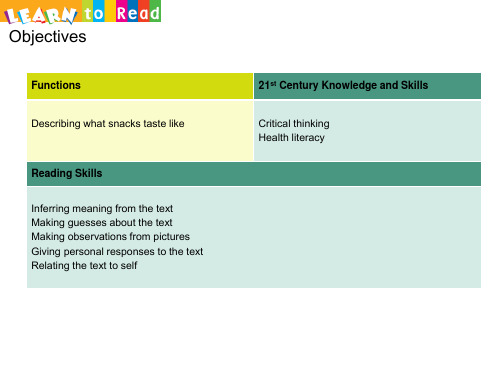
Second reading
Let’s watch the video and read the story again!
Activity 1
Answers
Post-reading
Let’s do some more activities!
Activity 2
Activity 34
Who says these words in the story?
Activity 34
Who says these words in the story?
Can I have some chocolate …?
Activity 4
Spin and say!
Start
Stop: press ‘1’
Chilli
sauce
Re-start: press ‘~’
Objectives
Functions
Describing what snacks taste like
Reading Skills
Inferring meaning from the text Making guesses about the text Making observations from pictures Giving personal responses to the text Relating the text to self
Are chocolate and lemon sweets good for you?
Shared reading
What are Charlie and Cherry doing?
Do you think Dad wants some lemon sweets too?
香港朗文英语二年级下Unit 5 Our day
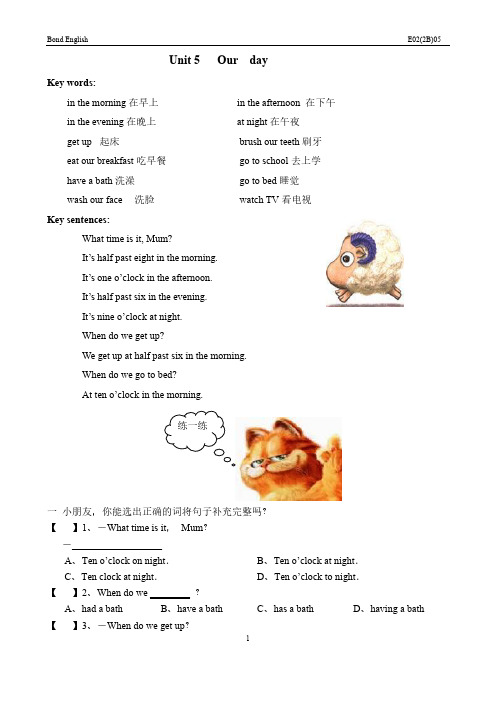
Unit 5 Our dayKey words:in the morning 在早上 in the afternoon 在下午 in the evening 在晚上 at night 在午夜 get up 起床brush our teeth 刷牙 eat our breakfast 吃早餐 go to school 去上学 have a bath 洗澡go to bed 睡觉 wash our face 洗脸watch TV 看电视Key sentences:What time is it, Mum?It ’s half past eight in the morning. It ’s one o ’clock in the afternoon. It ’s half past six in the evening. It ’s nine o ’clock at night.When do we get up?We get up at half past six in the morning. When do we go to bed? At ten o ’clock in the morning.一 小朋友,你能选出正确的词将句子补充完整吗? 【 】1、-What time is it , Mum ? -__________________ A 、Ten o ’clock on night . B 、Ten o ’clock at night . C 、Ten clock at night . D 、Ten o ’clock to night . 【 】2、When do we ________ ? A 、had a bathB 、have a bathC 、has a bathD 、having a bath【 】3、-When do we get up ?-________ 7:30.A、InB、OnC、AtD、To 【】4、-When do we go to bed?-We go to bed at half ________ nice.A、toB、pastC、inD、on 【】5、-What time is it,Jack?-It’s seven o’clock ________ the evening.A、atB、toC、onD、in 【】6、Welcome ________ my home.A、toB、inC、atD、on 【】7、Let’s ________ to school.A、gosB、goesC、goD、going 【】8、When do we brush our ________?A、toothB、toothsC、teethD、toothes 9.-What time is it,Tom?-It’s half past seven ________ the morning.A、inB、atC、inD、on 【】10、We go to school now.Come ________!A、inB、onC、atD、to二小小翻译家,你来试一试吧,将下列词组英汉互译.1. brush our teeth2.起床3. eat our breakfast4.上学5. wash our face6.洗澡7. eat our lunch 8.睡觉9. do our homework 10.看电视三大家一起来写句子,看谁写得又快又准!1. ?It’s half past eight in the morning.2. When do you go to school?(请按你的情况作答)3. What time is it?(请按“晚上六点半”作答)4. When do you have a bath?(请按你的情况作答)5. When do you go to bed?(请按你的情况作答)四、比一比,赛一赛,看看哪个小朋友能正确使用“past”,“o’clock”.1.四点半2.一点3.两点半4.三点5.八点半6.五点7.九点半8.十点9.七点半10.六点每个人的生日树 Birthday TreeJuly 15 to July 25 ............... ..........Elm Tree(榆树) July 26 to August 4 .............. ........Cypress Tree(柏树) August 5 to August 13 ............ ......Poplar Tree(白杨) August 14 to August 23 ........... .... Cedar Tree(雪松) August 24 to September 2 ......... ...Pine Tree(松树)September 3 to September 12 ...... Weeping Willow Tree(垂柳) September 13 to September 22 ..... Lime Tree(欧椴树、酸橙树) September 23 ..................... ........Olive Tree(橄榄树) September 24 to October 3 ........ .. Hazelnut Tree(榛树)。
- 1、下载文档前请自行甄别文档内容的完整性,平台不提供额外的编辑、内容补充、找答案等附加服务。
- 2、"仅部分预览"的文档,不可在线预览部分如存在完整性等问题,可反馈申请退款(可完整预览的文档不适用该条件!)。
- 3、如文档侵犯您的权益,请联系客服反馈,我们会尽快为您处理(人工客服工作时间:9:00-18:30)。
香港朗文二年级下册 Revised by BLUE on the afternoon of December 12,2020.
Chapter 1 Buying snacks
第一课购买零食
Key Words
关键词
sour plums
酸梅
lemon sweets
柠檬糖果
sweets
糖果
raisins
葡萄干
chocolate
巧克力
potato chips
炸土豆片
cheese rings
奶酪圈
peanuts
花生
ginger
姜
chilli fish
辣椒鱼
curry beef balls
咖喱牛肉丸
A Tom and Beeno's mothers are buying snacks for their children. Read.
A 汤姆和Beeno的妈妈正在为她们的小孩购买零食。
阅读。
1 Beeno likes chilli fish.
1 Beeno喜欢辣椒鱼。
2 Tom likes potato chips.
2 汤姆喜欢炸土豆片。
3 Let's get potato chips and chilli fish.
3 我们去拿炸土豆片和辣椒鱼吧。
B What else do Tom and Beeno like What snacks do you like
B 汤姆和Beeno另外还喜欢什么你喜欢什么零食
Here's an example.
例子
(Listening)
(听力练习)
Learn to read.
学着读。
C What snacks do the Chow family like Read and find out.
C 周一家喜欢什么零食?阅读,找出答案。
1 Charlie, Cherry and their mother are in the supermarket.
1 查理和查瑞还有他们的妈妈正在超级市场里面。
The children want some snacks. Charlie likes lemon sweets but Cherry does not like them.
小朋友们想要一些零食。
查理喜欢柠檬糖果,但是查瑞不喜欢它们。
She thinks they are too sour.
她认为柠檬太酸了。
May I have some lemon sweets please, Mum?
妈妈,我可以要一些柠檬糖果吗?
Can I have chocolate, Mum It's sweet.
妈妈,我可以要一些巧克力吗?它们很甜。
2 Ok. Here you are, Cherry. Don't eat too much.
2 好的,给你,查瑞。
不可以吃太多。
3 Here you are, Charlie. Don't eat too many, only two a day.
3 查理,给你。
不可以吃太多,一天只能吃两颗。
Thanks, Mum!
谢谢您,妈妈!
4 I love lemon sweets.
4 我喜欢柠檬糖果。
Dad likes lemon sweets too.
爸爸也喜欢柠檬糖果。
5 It is Charlie's bedtime.
5 查理的就寝时间到了。
No sweets at bedtime, Charlie. They're not good for your teeth.
查理,就寝时间不可以吃糖果。
它们对你的牙齿不好。
6 Can I have some lemon sweets, Charlie?
6 查理,我可以吃一些柠檬糖果吗?
Can Dad eat some lemon sweets now why
爸爸现在可以吃一些柠檬糖果吗为什么
7 Yes, you can. It isn't your bedtime yet.
7 是的,可以。
您的就寝时间还没有到。
D Circle the correct pictures.
D 圈出正确图画。
1 How many packets of lemon sweets does Mrs Chow buy?
1 周太太买了多少包柠檬糖果?
2 Who likes lemon sweets?
2 谁喜欢柠檬糖果?
3 How many sweets a day can Charlie eat?
3 查理一天可以吃多少颗糖果?
Phonics
语音
Say the sounds and the words.
说这些发音和单词。
ch
ch
cheese
奶酪
chocolate
巧克力
j
juice
果汁
jeans
牛仔裤
Can you say these words?
你会说这些单词吗?
Cherry
查瑞
Jerry
杰瑞
Pre-task Activity
作业前活动
E Tom and Beeno are buying snacks for their brothers. Act Tom and Beeno.
E 汤姆和Beeno正在为他们的弟弟买零食。
扮演Tom和Beeno。
Here are some examples.
这是一些例子。
Billy doesn't like peanuts. They're too salty. Does Bobo like peanuts? 比利不喜欢花生。
它们太咸了。
波波喜欢花生吗?
Yes, he does. He also like chilli fish. Does Billy like chilli fish?
是的,他喜欢。
他也喜欢辣椒鱼。
比利喜欢辣椒鱼吗?
No, he doesn't. It's too hot. He likes cookies.
不,他不喜欢。
它太辣了。
他喜欢饼干。
Now you try.
现在你来试。
Do Billy and Bobo like the other snacks Listen and put a tick or a cross. 比利和波波喜欢其他的零食吗?聆听,打勾或打叉。
(Listening)
(听力练习)
Task
作业
Do a survey of the snacks your friends like and do not like. Tell the teacher the results.
做一个关于你的朋友喜欢和不喜欢的零食的调查。
把结果告诉老师。
Language Fun
趣味语言
F Play a memory game. Choose the things you like from the fast food shop.
F 玩一个记忆游戏。
从快餐店中选出你喜欢的食物。
Here is an example
下面是些例子
What do you like?
你们喜欢什么?
I like hot dogs.
我喜欢热狗。
I like hot dogs and hamburgers.
我喜欢热狗和汉堡包。
I like hot dogs, hamburgers and cookies.
我喜欢热狗,汉堡包和饼干。
Now you try.
现在你来试。
